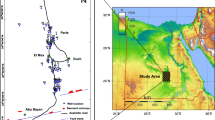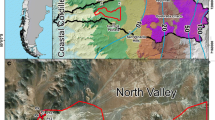Abstract
Based on the long-term monitoring data of rainfall, groundwater levels, groundwater abstraction, spring flow rates and groundwater quality, an assessment has been undertaken of the sustainable yield of a karst aquifer system in Shandong Province, northern China, to maintain perennial outflow of the karst springs while meeting water demands. One of the fundamental indicators for sustainable yield of groundwater is identified as maximum allowable water-level drawdown. A regional three-dimensional finite-difference numerical model has been developed to optimize the schemes associated with well fields and their locations and sustainable yields, in the Jinan spring catchment and its adjacent karst groundwater catchments, with the aim of maintaining the water level higher than the allowable lowest water level of 27.5 m above sea level. Furthermore, measures necessary to move towards sustainable use of the karst groundwater are outlined, drawing on contingency plans of water-source replacement and artificial recharge, dual water supply (based in water quality), use of the spring waters themselves, and groundwater quality protection.
Résumé
Basée sur les chronique long terme des précipitations, niveaux de nappe, prélèvements, débit des sources et qualité de l’eau, une estimation de la pérennité du d’un système aquifère karstique, Province de Shandong, Chine du Nord, une évaluation a été entreprise pour maintenir la pérennité du débit des sources karstiques tout en satisfaisant la demande en eau. Un des indicateurs fondamentaux de débitd’exploitationdurable est identifié comme étant le rabattement maximum admissible.Un modèle numérique tridimensionnel basé sur la méthode des différences finies a été développé pour optimiser le schéma des champs captant avec pour objectif le maintien duniveaud’eau à une cote supérieure à la cote minimale acceptable de 27.5 m au dessus du niveau de la mer.De plus, les mesures nécessaires pour s’acheminer vers une utilisation durable de la nappe du karst sont avancées, avecschémas pour une éventuellesubstitution de la ressource et recharge artificielle, approvisionnement double (basé sur la qualité de l’eau), utilisation des eaux de source elles-mêmes, et protection de la qualité de la nappe.
Resumen
Se ha llevado a cabo una evaluación del rendimiento sustentable de un sistema acuífero kárstico en la Provincia de Shandong, norte de China, basado en datos de monitoreos a largo plazo de la precipitación, niveles de agua subterránea, extracción de agua subterránea, caudal de los manantiales y calidad del agua subterránea, para mantener un flujo de salida perenne de los manantiales al mismo tiempo de satisfacer las demandas de agua. Uno de los indicadores fundamentales para el rendimiento sustentable de agua subterránea está identificado como el máximo permitido de la depresión del nivel de agua. Se ha desarrollado un modelo numérico regional de diferencias finitas para optimizar los esquemas asociados con campos de pozos y sus ubicaciones y rendimientos sustentables, en la cuenca de los manantiales Jinan y sus cuencas adyacentes de aguas subterráneas kársticas, con el objetivo de mantener más alto el nivel de agua que el nivel de agua mínimo permitido e de 27.5 m debajo del nivel del mar. Más aún, se indican las medidas necesarias para tender hacia un uso sustentable del agua subterránea kárstica, sobre la base de planes de contingencia de reposición y recarga artificial del recurso agua, abastecimiento dual de agua (basado en la calidad del agua), uso de las mismas aguas de manantiales, y la protección de la calidad del agua subterránea.
摘要
根据降水量、地下水位、地下水开采量、泉流量和地下水水质的长期动态监测资料,本文计算评价了中国北方山东省一典型岩溶含水层系统在保持泉水长年喷涌和满足供水需求条件下的可持续开采量。作者提出了地下水可持续开采量的最基本指标之一为最大允许水位降深。在保持地下水位高于最低允许水位标高即27.5米的前提下,建立济南泉域及其相邻岩溶水文地质单元的区域三维有限差分数学模型,优化出了地下水水源地的开采布局、位置和可持续开采量。同时,提出了岩溶地下水可持续利用的对策,包括供水水源置换与人工补给应急方案、分质供水、泉水先观后用、地下水水质保护等。
Resumo
Com base em monitorização de longo prazo da precipitação, dos níveis piezométricos, da extracção de água subterrânea, do fluxo em nascentes e da qualidade da água subterrânea, foi realizada uma avaliação dos caudais de exploração sustentáveis num sistema aquífero da Província de Shandong, no norte da China, de modo a manter os caudais naturais permanentes das nascentes cársicas, ao mesmo tempo que se satisfazem as necessidades em água das populações. Um dos indicadores fundamentais para a exploração sustentável da água subterrânea é a identificação do rebaixamento máximo permissível dos níveis piezométricos. Na bacia hidrológica das nascentes de Jinan e nas bacias cársicas adjacentes foi desenvolvido um modelo numérico regional tridimensional de diferenças finitas, a fim de optimizar os esquemas e a localização dos campos de captação e as suas taxas de exploração, com o objectivo de manter o nível da água acima do valor mínimo permitido de 27.5 m acima do nível do mar. Para além disso, são delineadas medidas necessárias para garantir a sustentabilidade do uso da água do sistema cársico, criando planos de contingência para substituição dos abastecimentos e para a recarga artificial, para abastecimento de água múltiplo (baseado na qualidade da água), para o uso das águas das próprias nascentes e para a protecção da água subterrânea.














Similar content being viewed by others
References
Alley MW, Leake AS (2004) The journey from safe yield to sustainability. Ground Water 42(1):181–185
Alley MW, Reilly ET, Franke OL (1999) Sustainability of ground-water resources. US Geol Surv Circ 1186
Barlow MP, Alley MW, Myers ND (2004) Hydrologic aspects of water sustainability and their relation to a national assessment of water availability and use. Water Resources Update, Issue, 127, Universities Council on Water Resources, Carbondale, IL
Brown LJ, Dravid PN, Hudson NA (1999) Sustainable groundwater resources, Heretaunga Plains, Hawke’s Bay, Zew Zealand. Hydrogeol J 7:440–453
Dufresne DP, Drake CW (1999) Regional groundwater flow model construction and wellfield site selection in a karst area, Lake City, Florida. Eng Geol 52(1–2):129–139
Harbaugh AW, Banta ER, Hill MC, McDonald (2000) MODFLOW 2000: The U.S. Geological Survey modular ground-water model—User guide to modularization concepts and the ground-water flow process. US Geol Surv Open-File Rep
Kalf RPF, Woolley RD (2005) Applicability and methodology of determining sustainable yield in groundwater systems. Hydrol J 13:295–312
Kang FX (2005) Allowable yield of groundwater and its potential evaluation. Geotech Investig Surveying 2:29–33
Li CM (1985) Karst groundwater resources and springs protection in Jinan City. Carsol Sin 1(2):31–39
Li CM, Kang FX (1999) Karst groundwater modeling with respect to withdrawal augmenting (in Chinese). Shandong Scientific Press, Jinan City, China
Li CM, Li L, Tao WW (2002) Current and long term countermeasures for springs protecting and meeting water demand in Jinan City (in Chinese). Geology in Shandong Province 18(6):37–40
Li FL, Ma JG, Li YG (2003) Study on controlling parameters of Jinan spring groups gushing and macro-methods of spring protection and water supply. Carsologica Sin 3:188–194
Ma T, Wang YX, Guo QH (2004) Response of carbonate aquifer to climate change in northern China: a case study at the Shentou karst springs. J Hydrol 297:274–284
Mahler JB, Garner DB (2009) Using nitrate to quantify quick flow in a karst aquifer. Ground Water 47(3):350–360
Qian JZ, Zhan HB, Wu YF, Li FL, Wang JQ (2006) Fractured-karst spring-flow protections: a case study in Jinan, China. Hydrogeol J 14:1192–1205
Ravbar N, Goldscheider N (2007) Proposed methodology of vulnerability and contamination risk mapping for the protection of karst aquifers in Slovenia. Acta Carsologica 36(3):397–411
Scanlon BR, Mace RE, Barrett ME, Smith B (2003) Can we simulate regional groundwater flow in a karst system using equivalent porous media models? Case study, Barton Springs Edwards aquifer, USA. J Hydrol 276:137–158
Sharp JMJ (1998) Sustainable groundwater supplies-an evolving issue: examples from major carbonate aquifers of Texas, USA. In: Weaver TR, Lawrence CR (eds) Groundwater sustainable solutions. Proc Int Groundwater Conf, 8–13 Feb 1998, Int Assoc Hydrogeologists, Melbourne, Australia, pp 1–12
Sophocleous MA (1997) Managing water resources systems: why “safe yield” is not sustainable. Ground Water 35:561
Sophocleous MA (2000) From safe yield to sustainable development of water resources: the Kansas experience. J Hydrol 235:27–43
Sophocleous MA (2005) Groundwater recharge and sustainability in the High Plains aquifer in Kansas, USA. Hydrol J 13:351–365
Taylor JC, Alley MW (2001) Ground-water-level monitoring and the importance of long-term water-level data. US Geol Surv Circ 1217
Wang JQ, Wu YF, Qian JZ, Li FL (2004) Scheme of groundwater exploitation to keep springs spurting and water supply in Jinan springs zone. J Agri Environ Sci 23(6):1228–1231
Wang QB, Xing LT, Gan D (2009) Groundwater flow modeling in the Jinan karst spring area. Hydrogeol Eng Geol 5:53–60
White WB (1988) Geomorphology and hydrology of karst terrains. Oxford University Press, New York, 464 pp
Worthington SRH (2009) Diagnostic hydrogeologic characteristics of a karst aquifer (Kentucky, USA). Hydrogeol J 17:1665–1678
Wu AM, Cheng XM, Zhao SQ, Kang FX (2003) Jinan Springs. Huanghe Press, Jinan City, China
Wu Q, Xing LT, Zhou WF (2010) Utilization and protection of large karst springs in China. In: Kresic N, Stevanovic Z (eds) Groundwater hydrology of springs. Elsevier, Amsterdam
Wu XB (2004) Countermeasures for groundwater protection for spring regions of Jinan City. Water Resour Prot 5:64–67
Xing LT, Wu Q, Xu JX, Zhou R (2009) Discussion on environmental capacity of ground water: a case study of Ji′nan spring basin, Shandong, China. Geol Bull China 28(1):124–129
Xu JX, Duan XM, Tong GY (2004) Groundwater environment evolution and protection in Jinan spring catchment. Hydrogeol Eng Geol 6:69–72
Zhou YX (2009) A critical review of groundwater budget myth, safe yield and sustainability. J Hydrol 370:207–213
Acknowledgements
This study was supported in part by the 973 Program (2010CB428802) and the National Natural Science Foundation of China (40772155). The authors also wish to express heartfelt thanks to Z. Sheng, V. Post, P. Renard, S. Schemann, N. Goldscheider, J. Meiman and two anonymous reviewers for their constructive comments and suggestions for improvement of the manuscript.
Author information
Authors and Affiliations
Corresponding author
Rights and permissions
About this article
Cite this article
Kang, F., Jin, M. & Qin, P. Sustainable yield of a karst aquifer system: a case study of Jinan springs in northern China. Hydrogeol J 19, 851–863 (2011). https://doi.org/10.1007/s10040-011-0725-2
Received:
Accepted:
Published:
Issue Date:
DOI: https://doi.org/10.1007/s10040-011-0725-2




